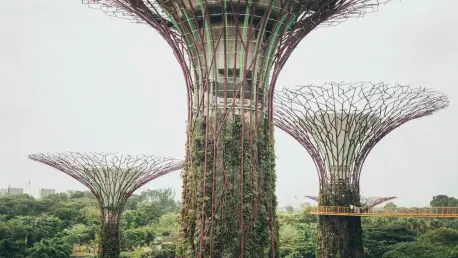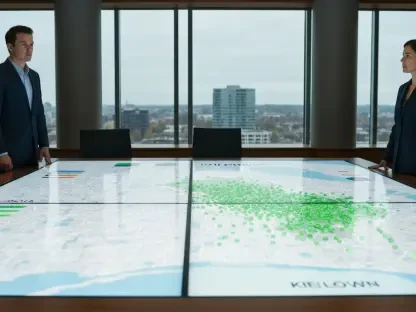In a world increasingly conscious of its environmental footprint, the field of landscape architecture is undergoing a transformative shift. This evolution is largely spearheaded by visionary figures like Thomas Woltz, whose approach integrates ecological and cultural narratives into the very fabric of public spaces. This reimagining moves beyond mere beautification or traditional horticulture, delving deeply into the historical and ecological stories that the land itself can tell. In this narrative-driven vision, landscape architecture is being revitalized as a discipline of storytelling—a collaborative effort that requires an understanding of historical contexts and ecological nuances. As a result, landscape architects are tasked not only with creating aesthetically pleasing environments but also ones that resonate with the stories of the landscapes they inhabit.
Rethinking Landscape Architecture’s Role
From Garden Design to Public Spaces
Landscape architecture, traditionally mistaken for mere garden design, is expanding its scope to redefine public spaces. This expansion seeks to encompass historical, cultural, and ecological narratives, shining a light on the significance of the land’s stories. At the forefront of this movement is Thomas Woltz, Senior Principal of Nelson Byrd Woltz (NBW), whose recent efforts aim to highlight the multilayered aspects of landscape design. Unlike the more conventional and aesthetic-focused garden projects, the contemporary practice is keen to include varied narratives that lie within natural settings. The process demands an integrative approach, combining elements of conservation, restoration, and sustainable planning.
NBW’s projects are a testament to this philosophy, often incorporating the consultation of restoration ecologists and cultural landscape historians. These collaborations ensure that each project reflects the intricate tapestry of its surroundings, fostering a narrative-rich experience for the public. Woltz’s recently published book, “The Land is Full,” presents twelve projects that demonstrate how public parks, memory sites, and gardens can be designed to respect and preserve the ecological and cultural narratives inherent in each site. This book is part of a planned series that hopes to change the public’s perception of landscape architecture, suggesting it as an academic and practical field with far-reaching impact beyond patios and plots.
Integration of Ecological Practices
One notable aspect of Woltz’s approach is the integration of ecological storytelling within landscape architecture. This is crucial in a time when climate change and environmental degradation are pressing concerns. By embedding ecological narratives into their designs, Woltz and his team at NBW exemplify how landscape architecture can serve as a platform for raising awareness and fostering environmental stewardship. Each project is carefully curated to resonate with the natural history of the site, thus creating a holistic experience that informs as well as inspires. They seek to ensure that the green spaces they create are not just sustainable but also educational, allowing visitors to engage with and learn from the environment.
Moreover, this approach involves leveraging local flora and fauna, promoting biodiversity, and restoring native ecosystems. Through these strategies, NBW transforms landscapes into living narratives that both celebrate and preserve the natural world. This method not only adds depth to public spaces but also ensures they are resilient and ecologically sound. As a result, ecological storytelling has extended the purview of landscape architecture from a design-focused discipline to one that supports ecological balance. Additionally, this method attempts to make individuals see themselves as part of a larger environmental narrative, thereby fostering a sense of responsibility and action in the face of environmental challenges.
The Power of Storytelling in Design
Multidisciplinary Collaboration
A cornerstone of project success is the collaborative effort that stems from engaging multiple disciplines in the design process. This emphasis on teamwork allows for diverse perspectives and expertise to inform the development of landscapes that are both functional and narratively rich. NBW’s practice of including cultural landscape historians and restoration ecologists ensures that each site’s history and ecological aspects are woven into its design. This approach underscores the importance of understanding both the cultural and environmental history of a site to produce spaces that accurately reflect their inherent stories.
By collaborating across disciplines, landscape architects nurture environments that are authentic and resonant, creating spaces that are as meaningful as they are functional. Moreover, this teamwork encourages an ongoing dialogue between different fields, which can lead to innovative solutions and design strategies. Projects such as the Flight 93 National Memorial exemplify how multidisciplinary collaboration enriches the design process, allowing for a nuanced reflection of both the site’s memorial significance and its existing ecological framework. It’s through such multifaceted insights that NBW manages to carefully balance aesthetics, ecology, and cultural history, making each project unique and impactful.
Education Through Design
The narrative-driven approach to landscape architecture also emphasizes the educational potential of design. By imbuing landscapes with stories, these environments become platforms for learning and engagement. Visitors are encouraged to explore and interact with the spaces, uncovering layers of history and ecology embedded within. This educational aspect is paramount to NBW’s projects, as it fosters a deeper connection between people and the land. Such an immersive experience can be transformative, broadening the public’s understanding of ecosystem dynamics and cultural history while cultivating a lasting appreciation for conservation efforts.
Education through design not only enriches public spaces but also elevates landscape architecture as a field that contributes to public discourse and societal development. Making knowledge accessible and engaging through thoughtfully crafted environments not only informs but also inspires stewardship and community involvement. It’s an approach that positions landscape architecture as an essential bridge between people and place, using storytelling and education as central tenets in cultivating meaningful and sustainable connections.
Legacy of Ecological Storytelling
Influencing Future Generations
This narrative and ecologically-driven approach to landscape architecture holds significant influence over future generations. By integrating storytelling with design, Woltz and his team at NBW are creating a legacy of landscapes that inspire and educate. This method instills a greater appreciation for nature and a deeper understanding of the importance of preserving ecological and historical narratives for future generations. The impact of these designs goes beyond the immediate experience, encouraging individuals to carry these stories into their own lives, shaping perspectives on the environment and sustainability.
Moreover, such initiatives demonstrate how design can play a pivotal role in environmental education and advocacy, potentially inspiring new generations of landscape architects, ecologists, and historians. As young professionals observe and learn from these projects, there is an opportunity to continue pushing the boundaries of what landscape architecture can achieve. The integration of multidisciplinary insights and ecological narratives ensures that future designs will continue to evolve, addressing environmental challenges with both creativity and sensitivity. This legacy nurtures a commitment to sustainable practices within the profession, influencing both contemporary and future approaches to landscape design.
Expanding the Discipline’s Horizons
Landscape architecture, often mistaken for simple garden design, is broadening its scope to redefine public spaces by incorporating historical, cultural, and ecological narratives that underscore the land’s stories. Leading this transformation is Thomas Woltz, Senior Principal of Nelson Byrd Woltz (NBW), a firm championing complex and meaningful landscape design. Unlike traditional projects focused merely on aesthetics, today’s practice embraces diverse narratives embedded in natural environments, demanding a comprehensive approach that integrates conservation, restoration, and sustainable planning.
NBW exemplifies this philosophy, frequently collaborating with restoration ecologists and cultural landscape historians to ensure that every project captures the intricate tapestry of its surroundings, creating an enriching experience for the public. Woltz’s book, “The Land is Full,” features twelve projects illustrating how public parks, memorial sites, and gardens can honor and preserve the ecological and cultural narratives inherent in each location, part of a series aimed at transforming public perception of landscape architecture beyond mere garden setups.









